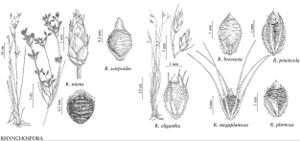Rhynchospora intermedia
Trans. New York Acad. Sci. 11: 87. 1892.
Plants perennial, mostly densely cespitose, 20–70 cm, base deep rich redbrown; rhizomes absent. Culms erect to ascending, leafy, stiff. Leaves shorter than scape; blades narrowly linear, (1–)2–3 mm wide, margins involute, apex trigonous, tapering. Inflorescences: clusters 1–2, if 2 then close together, dense, broadly turbinate to hemispheric or lobedglobose; primary leafy bract linear, stiff, exceeding clusters. Spikelets light to dark redbrown, lanceovoid, 3.5–6 mm, apex acuminate; fertile scales ovate, convex, 3–3.5(–4) mm, apex acuminate, low midrib excurrent or not. Flowers: perianth bristles 6, reaching at least to tubercle base, plumose from base to more than 1/2 length of fruit body. Fruits 1(–2) per spikelet, (2–)2.5–2.8(–3) mm; body redbrown or brown, tumidly obovoid, (1.5–)2–2.2 × 1–1.7 mm; surfaces interruptedly transversely rugulose; tubercle broadly conic, 0.5–0.8(–1) mm, base broadly 2lobed, apex often apiculate.
Phenology: Fruiting spring–fall or all year.
Habitat: Sands and sandy peat of bog margins, pinelands and pine saw palmetto flats among wiregrass
Elevation: 0–200 m
Distribution

Fla., West Indies (Cuba).
Discussion
Rhynchospora intermedia is distinguished from taller extremes of R. plumosa by its thicker leaves and scapes and its longer spikelets and fruit. Its bases are a deep rich red-brown rather than the pale brown or dull deep brown of R. plumosa.
Rhynchospora pineticola C. B. Clarke is a superfluous, illegitimate name that pertains here.
Selected References
None.
